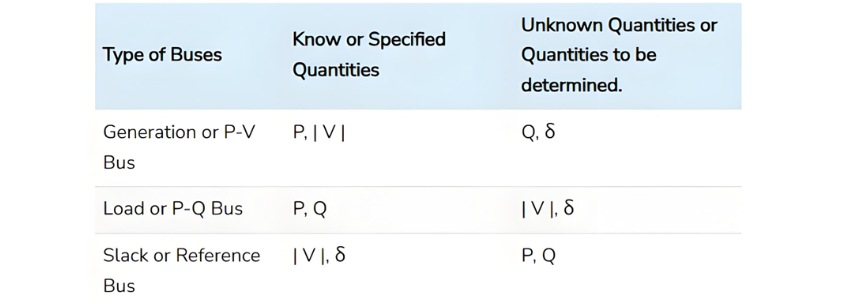Definition and Classification of Buses in Power Systems
In a power system, a bus is defined as a connection point, typically represented as a vertical line, where various system components such as generators, loads, and feeders are interconnected. Each bus in a power system is characterized by four key electrical quantities: the magnitude of the voltage, the phase angle of the voltage, active power (also known as true power), and reactive power. These quantities play a crucial role in analyzing and understanding the behavior and performance of the power system.
During load flow studies, which aim to analyze the steady - state operating conditions of a power system, out of the four quantities associated with each bus, two are known, and the remaining two need to be determined. Based on which of these quantities are specified, buses can be classified into three distinct categories: generation buses, load buses, and slack buses. This classification helps in formulating and solving load flow equations, enabling engineers to effectively analyze power system operation, plan for power generation and distribution, and ensure the overall stability and reliability of the electrical grid.
The table shown below shows the types of buses and the associated known and unknown value.

Generation Bus (Voltage Control Bus or P-V Bus)
The generation bus, often referred to as the P-V bus, is a key element in power system analysis. On this type of bus, two parameters are pre-specified: the magnitude of the voltage, which aligns with the generated voltage, and the active power (true power) P, corresponding to the generator's rating. To maintain the voltage magnitude at a constant, specified value, reactive power is injected into the system as needed. As a result, the reactive power generation Q and the phase angle δ of the voltage at the P-V bus are the unknowns that must be calculated through power system analysis algorithms. This process is crucial for ensuring the stability and proper operation of the power grid, as maintaining a consistent voltage level is essential for reliable power delivery.
Load Bus (P-Q Bus)
The load bus, also known as the P-Q bus, serves as the connection point where both active and reactive power are drawn from or injected into the electrical network. In the context of load flow studies, at this bus, the active power P and reactive power Q values are specified based on the characteristics of the connected loads. The main unknowns here are the magnitude and phase angle of the voltage. While the load bus voltage is allowed to vary within a tolerable range, typically around 5%, maintaining it within these limits is vital for the proper functioning of connected electrical devices. For loads, the phase angle δ of the voltage is relatively less critical compared to the voltage magnitude, as most electrical appliances are designed to operate effectively within a certain range of voltage magnitudes.
Slack, Swing or Reference Bus
The slack bus plays a unique and essential role in power systems. Unlike other buses, it does not directly supply power to any physical load. Instead, it acts as a power reservoir, capable of absorbing or injecting both active and reactive power into the power system as required. In load flow analysis, the magnitude and phase angle of the voltage at the slack bus are predefined. Conventionally, the phase angle of the voltage at this bus is set to zero, making it a reference point for the entire power system. The active and reactive power values for the slack bus are determined during the solution of load flow equations.
The concept of the slack bus emerges from the practical challenges of load flow calculations. Since the I2R losses within the power system cannot be accurately predicted beforehand, it becomes impossible to precisely specify the total injected power at each individual bus. By designating a slack bus, engineers can balance the power equations across the system, ensuring that the overall power flow calculations are consistent and accurate. The zero - phase - angle convention at the slack bus simplifies the mathematical modeling and analysis of the power system, facilitating a more straightforward understanding of the electrical relationships and power exchanges within the grid.